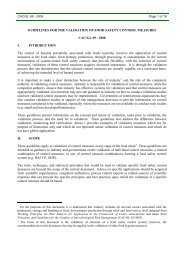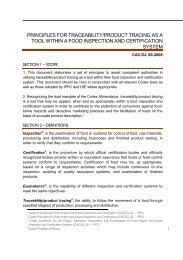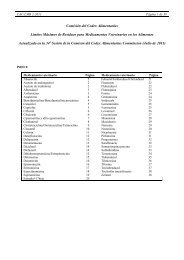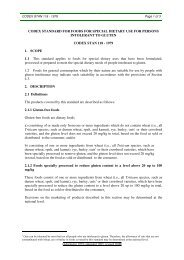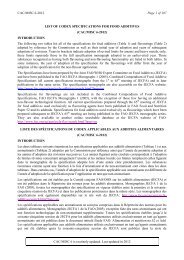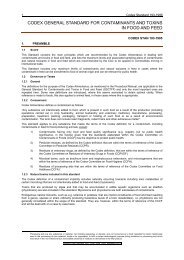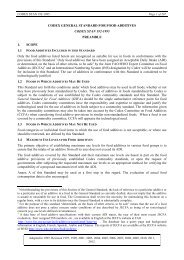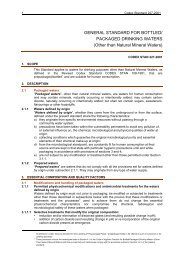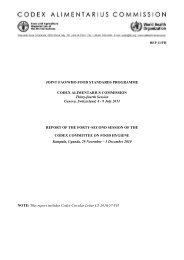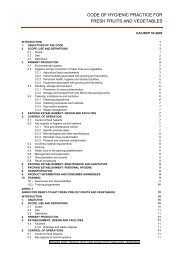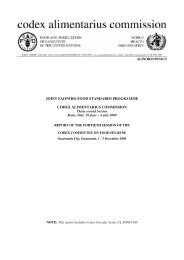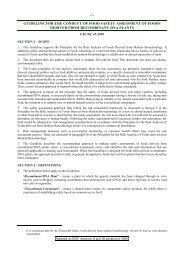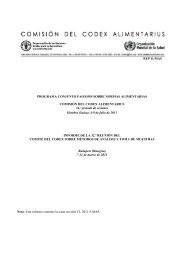alinorm 09/32/41 - CODEX Alimentarius
alinorm 09/32/41 - CODEX Alimentarius
alinorm 09/32/41 - CODEX Alimentarius
You also want an ePaper? Increase the reach of your titles
YUMPU automatically turns print PDFs into web optimized ePapers that Google loves.
ALINORM <strong>09</strong>/<strong>32</strong>/<strong>41</strong> 11<br />
DISCUSSION PAPER ON FUMONISINS (Agenda Item 9a) 19<br />
96. The Delegation of Brazil, as leading country of the electronic Working Group on Fumonisins,<br />
outlined the main aspects considered in the discussion paper in particular, available data, analytical methods,<br />
sampling plans, occurrence in foods, intake levels, exposure and risk assessment, risk management<br />
considerations and public health aspects as well as agricultural, technological and commercial aspects.<br />
Based on this information, the Delegation concluded that the Committee could consider the establishment of<br />
a maximum level and the development of a sampling plan for fumonisins in maize and maize products.<br />
97. The Committee focused its discussion on the conclusions and recommendations of the Working<br />
Group. Several delegations expressed the view that it would not be appropriate to propose a maximum level<br />
for consideration based upon occurrence data from before 2001, not taking into account the more recent<br />
occurrence data and the application of good agricultural and manufacturing practices to prevent the<br />
formation of fumonisins and that discussion on setting a maximum level for maize and derived maize<br />
products should focus on products intended for human consumption as maize can be used for other purposes<br />
than food such as feeds. It was also noted that it would be useful to asses the effectiveness of the<br />
implementation of the Code of Practice for the Prevention and Reduction of Mycotoxin Contamination in<br />
Cereals, including Annexes on Ochratoxin A, Zearalenone, Fumonisins and Tricothecenes (CAC/RCP 51-<br />
2003).<br />
98. Other delegations indicated that maize was a staple food in their countries and that the setting of a<br />
maximum level and accompanying sampling plan and analytical methods would assist in the reduction of<br />
consumers exposure to fumonisins as well as in the surveillance of locally produced foods and imported<br />
products. Some delegations were of the view that data review should also include feeds as in certain<br />
countries the intended use of maize was not always known, for example at the import stage. A Delegation<br />
also noted the importance of recommendations in paragraphs 82 and 83 of CX/CF <strong>09</strong>/03/9 so that efforts<br />
should be made to broaden the survey of bound fumonisins in extruded maize products, such as breakfast<br />
cereals, to better elucidate the potential release of Fumonisins B1 from these bound fumonisins in the human<br />
gastrointestinal tract and the need for further research on possible synergies or combined effects of<br />
fumonisins and aflatoxins on human health in those countries where maize and maize-based products were<br />
staple foods.<br />
99. The JECFA Secretariat noted that new available information on toxicology and occurrence data<br />
could provide the basis for a re-evaluation of fumonisins. The JECFA Secretariat furthermore pointed out<br />
that the discussion paper already contained some updated data since the last JECFA evaluation that the<br />
Committee could take into account in the development of a maximum level.<br />
100. The Representative of the International Atomic Energy Agency (IAEA) informed the Committee of<br />
the results of a study 20 undertaken in collaboration with the Nigerian National Agency for Food and Drug<br />
Administration and Control (NAFDAC) designed to assess the incidence and contamination levels of<br />
fumonisin B1 in maize samples marketed in five geographical locations in Nigeria. The study indicated that<br />
fumonisin B1 is a widespread contaminant of maize kernels in Nigeria and although various contamination<br />
levels were encountered across the five different areas, the overall results revealed relatively low levels of<br />
contamination. It was noted that the enforcement of good agricultural practices, including the disposal of<br />
visibly damaged kernels and screenings and fines, through cleaning procedures, and wet food processing,<br />
were strongly recommended to reduce the fumonisin B1 content, thus preventing exposure of consumers to<br />
harmful toxins in food. The representative of the IAEA offered to make the full results of the study available<br />
to the JECFA and the CCCF for the proposed future evaluation of fumonisins.<br />
19 CX/CF <strong>09</strong>/03/9 and CRD 8 (comments from the European Community); CRD 13 (Philippines); CRD 15<br />
(comments from Cuba); and CRD 17 (comments from Indonesia).<br />
20 CX/CF <strong>09</strong>/03/3-Add.1.



